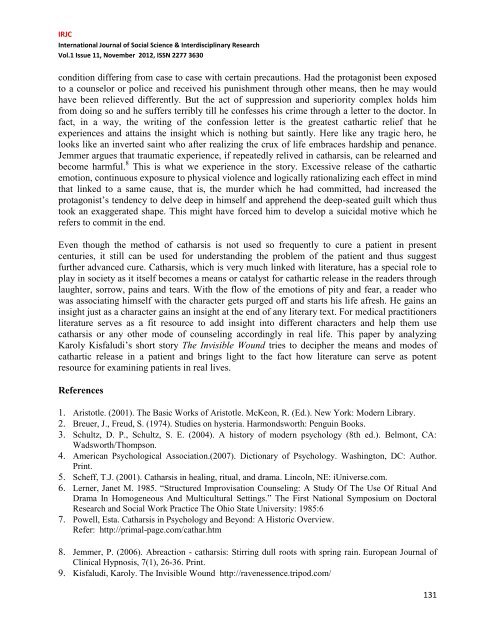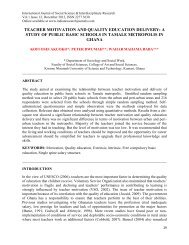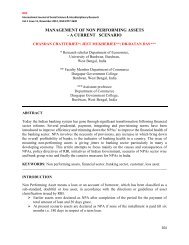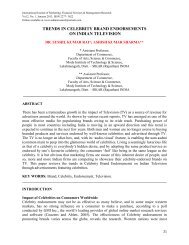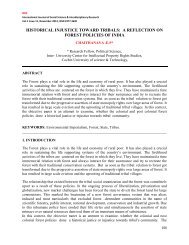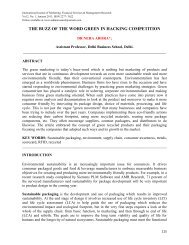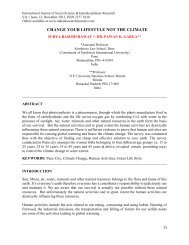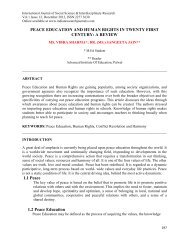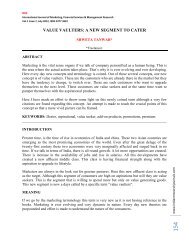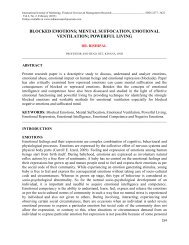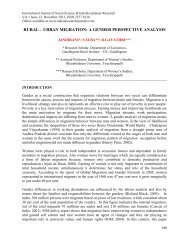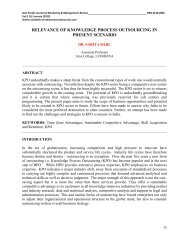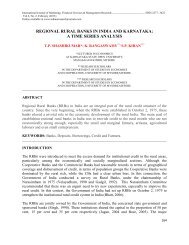dial v for violence: reading karoly kisfaludi's the invisible wound as a ...
dial v for violence: reading karoly kisfaludi's the invisible wound as a ...
dial v for violence: reading karoly kisfaludi's the invisible wound as a ...
You also want an ePaper? Increase the reach of your titles
YUMPU automatically turns print PDFs into web optimized ePapers that Google loves.
IRJC<br />
International Journal of Social Science & Interdisciplinary Research<br />
Vol.1 Issue 11, November 2012, ISSN 2277 3630<br />
condition differing from c<strong>as</strong>e to c<strong>as</strong>e with certain precautions. Had <strong>the</strong> protagonist been exposed<br />
to a counselor or police and received his punishment through o<strong>the</strong>r means, <strong>the</strong>n he may would<br />
have been relieved differently. But <strong>the</strong> act of suppression and superiority complex holds him<br />
from doing so and he suffers terribly till he confesses his crime through a letter to <strong>the</strong> doctor. In<br />
fact, in a way, <strong>the</strong> writing of <strong>the</strong> confession letter is <strong>the</strong> greatest cathartic relief that he<br />
experiences and attains <strong>the</strong> insight which is nothing but saintly. Here like any tragic hero, he<br />
looks like an inverted saint who after realizing <strong>the</strong> crux of life embraces hardship and penance.<br />
Jemmer argues that traumatic experience, if repeatedly relived in catharsis, can be relearned and<br />
become harmful. 8 This is what we experience in <strong>the</strong> story. Excessive rele<strong>as</strong>e of <strong>the</strong> cathartic<br />
emotion, continuous exposure to physical <strong>violence</strong> and logically rationalizing each effect in mind<br />
that linked to a same cause, that is, <strong>the</strong> murder which he had committed, had incre<strong>as</strong>ed <strong>the</strong><br />
protagonist‟s tendency to delve deep in himself and apprehend <strong>the</strong> deep-seated guilt which thus<br />
took an exaggerated shape. This might have <strong>for</strong>ced him to develop a suicidal motive which he<br />
refers to commit in <strong>the</strong> end.<br />
Even though <strong>the</strong> method of catharsis is not used so frequently to cure a patient in present<br />
centuries, it still can be used <strong>for</strong> understanding <strong>the</strong> problem of <strong>the</strong> patient and thus suggest<br />
fur<strong>the</strong>r advanced cure. Catharsis, which is very much linked with literature, h<strong>as</strong> a special role to<br />
play in society <strong>as</strong> it itself becomes a means or catalyst <strong>for</strong> cathartic rele<strong>as</strong>e in <strong>the</strong> readers through<br />
laughter, sorrow, pains and tears. With <strong>the</strong> flow of <strong>the</strong> emotions of pity and fear, a reader who<br />
w<strong>as</strong> <strong>as</strong>sociating himself with <strong>the</strong> character gets purged off and starts his life afresh. He gains an<br />
insight just <strong>as</strong> a character gains an insight at <strong>the</strong> end of any literary text. For medical practitioners<br />
literature serves <strong>as</strong> a fit resource to add insight into different characters and help <strong>the</strong>m use<br />
catharsis or any o<strong>the</strong>r mode of counseling accordingly in real life. This paper by analyzing<br />
Karoly Kisfaludi‟s short story The Invisible Wound tries to decipher <strong>the</strong> means and modes of<br />
cathartic rele<strong>as</strong>e in a patient and brings light to <strong>the</strong> fact how literature can serve <strong>as</strong> potent<br />
resource <strong>for</strong> examining patients in real lives.<br />
References<br />
1. Aristotle. (2001). The B<strong>as</strong>ic Works of Aristotle. McKeon, R. (Ed.). New York: Modern Library.<br />
2. Breuer, J., Freud, S. (1974). Studies on hysteria. Harmondsworth: Penguin Books.<br />
3. Schultz, D. P., Schultz, S. E. (2004). A history of modern psychology (8th ed.). Belmont, CA:<br />
Wadsworth/Thompson.<br />
4. American Psychological Association.(2007). Dictionary of Psychology. W<strong>as</strong>hington, DC: Author.<br />
Print.<br />
5. Scheff, T.J. (2001). Catharsis in healing, ritual, and drama. Lincoln, NE: iUniverse.com.<br />
6. Lerner, Janet M. 1985. “Structured Improvisation Counseling: A Study Of The Use Of Ritual And<br />
Drama In Homogeneous And Multicultural Settings.” The First National Symposium on Doctoral<br />
Research and Social Work Practice The Ohio State University: 1985:6<br />
7. Powell, Esta. Catharsis in Psychology and Beyond: A Historic Overview.<br />
Refer: http://primal-page.com/cathar.htm<br />
8. Jemmer, P. (2006). Abreaction - catharsis: Stirring dull roots with spring rain. European Journal of<br />
Clinical Hypnosis, 7(1), 26-36. Print.<br />
9. Kisfaludi, Karoly. The Invisible Wound http://ravenessence.tripod.com/<br />
131


